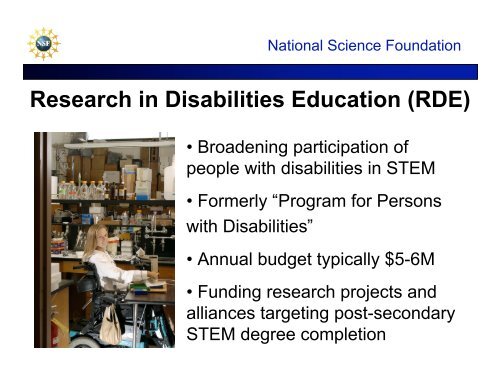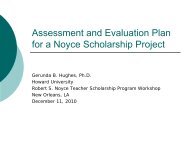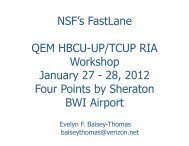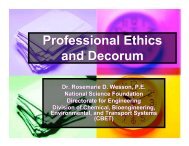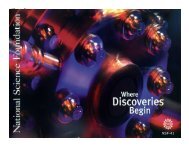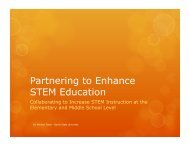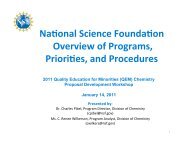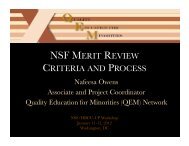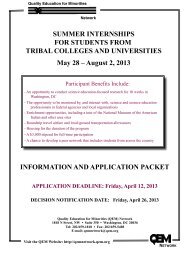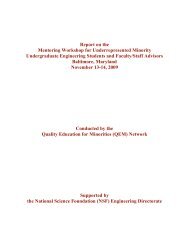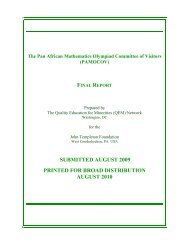Mark Leddy
Mark Leddy
Mark Leddy
- No tags were found...
You also want an ePaper? Increase the reach of your titles
YUMPU automatically turns print PDFs into web optimized ePapers that Google loves.
National Science FoundationResearch in Disabilities Education (RDE)• Broadening participation ofpeople with disabilities in STEM• Formerly “Program for Personswith Disabilities”• Annual budget typically $5-6M• Funding research projects andalliances targeting post-secondarySTEM degree completion
National Science FoundationDivision of Science Resource StatisticsEstimates of Disability in the United StatesPopulation 15-24Students 6-17STEM undergraduatesSTEM graduate studentsSTEM doctorate recipientsPopulation 25-64US workforce 21-64STEM workforceSTEM doctoral facultyPercent with disabilities11%12%11%7%1%16%10%5%8%Number with disabilities4,128,0005,708,900580,00030,00030724,350,00014,313,000242,70013,500SOURCES: Population and U.S. workforce—U.S. Census Bureau, Survey of Income and Program Participation, 2002; Students 6-17—U.S.Department of Education, Office of Special Education Programs, 2005; Undergraduate and graduate students—U.S. Department of Education,National Center for Education Statistics, National Postsecondary Student Aid Study, 2004; STEM doctorate recipients, NSF/SRS, Survey ofEarned Doctorates 2005, Workforce and doctoral faculty—National Science Foundation, SESTAT data system, and Survey of DoctorateRecipients.
National Science FoundationResearch in Disabilities EducationDivision of Human Resource DevelopmentDefinition of Disability• Physical or Mental Impairment thatSubstantially Limits a Major Life Activity• Record of Such an Impairment• Regarded as Having Such an Impairment
Research in Disabilities EducationTypes of DisabilitiesNational Science FoundationDivision of Human Resource Development• Attention Deficit Disorder (ADD)• Attention Deficit Hyperactivity Disorder (ADHD)• Deaf or Hard-of-Hearing (D/HoH)• Physical Disability/Orthopedic/Mobility Impairment• Systemic Health Condition• Psychological/Psychiatric Disability• Specific Learning Disability• Visual Impairment• Acquired Brain Injury• Other Disability
Research in Disabilities EducationNational Science FoundationDivision of Human Resource DevelopmentFY08 Program Solicitation (08-527)Demonstration, Enrichment, or Information Dissemination• Standard grants up to 2 yrs. and up to $150,000.• Demonstrate proof of concept for research studies.• Enrich student learning; Disseminate information.Focused Research Initiatives• Standard or Continuing grants up to 3 yrs. and up to $375,000.• Investigations of promising practices for STEM education.• Expanding knowledge base about students in STEM.Regional Alliances for Disabilities Education• Continuing grants up to 5 yrs. and up to $3,000,000.• Working with high school, 2-year and 4-year college students.• Increasing STEM degrees and entry to 4-year schools, graduateschool or industry.
Innovation Through InstitutionalIntegrationGLOBALLYENGAGEDWORKFORCEBROADENINGPARTICIPATIONCRITICALEDUCATIONALJUNCTURESRESEARCH& EVALUATIONINTEGRATIONOF RESEARCH& EDUCATION
Goals of I 3• Increase synergy & collaborationamong NSF/EHR-funded projects andwithin/ between institutions• Enhance sustainability• Promote integration of STEM researchand education• Broaden participation, attend to criticaleducational junctures, and/or providefor more globally engaged workforce• Encourage research on intra- or interinstitutionalintegration & broaderimpacts
National Science FoundationResearch in Disabilities EducationDivision of Human Resource DevelopmentSolicitation03-58704-61005-62305-62307-51108-527Fiscal Year200320042005200620072008Alliance1-11-5Research1466104Demonstration-31-2-Enrichment132-1-Dissemination123--2InnovationthroughInstitutionalIntegration-----2
Research in Disabilities EducationNational Science FoundationDivision of Human Resource DevelopmentDemonstration, Enrichment orInformation Dissemination Awards• ACCESS TO ADVANCEMENT: An Audio Exploration of the NationalEffort to Increase the Role of Women with Disabilities in Science,Technology, Engineering and Mathematics (0833247)• Disseminating Effective Practices for Describing STEM Content forPeople who are Blind or Visually Impaired (0833608)• Access By Design: A Faculty Development Model of STEMEducation for Undergraduate Students with Disabilities (0728555)• Developing and Evaluating a Peer Led Team Learning Curriculum inCalculus and Chemistry for Undergraduate Students with Learningand Attention Disabilities (0726664)• Universal Design in College Algebra: Customizing LearningResources for Two Year Students with Learning Disabilities (0726252)
Research in Disabilities EducationResearch AwardsNational Science FoundationDivision of Human Resource Development• Collaborative Research: Students with Learning Disabilities: STEMPathways in the Social Context(0834177 & 0834178)• A Randomized Study of the Impact of STEM Mentors withDisabilities on High School Students with Disabilities (0834195)• The Effects of Dyslexia on Scientists' Analysis of AstrophysicalData (0726032)• Supporting Math Access for Middle and High School Blind StudentsThrough Adaptive Math Tutoring Technology (0725917)• Supporting Deaf and Hard of Hearing Undergraduate Students inSTEM Field Settings with Remote Speech-to-Text Services (0726591)• Improving Access to STEM for Community College Students withDisabilities in Universally Designed Learning Communities (0726473)
National Science FoundationResearch in Disabilities EducationDivision of Human Resource DevelopmentAlliances for Students with Disabilities in STEM2008U of WashingtonU of WisconsinOhio St. UWright St. UU of So. MaineCity U of NY –Hunter Col.New Mexico St. U
National Science FoundationResearch in Disabilities EducationDivision of Human Resource DevelopmentAlliance Practices for Students• Stipends• Getting Mentored• Research Experience• Peer Tutoring• Student LearningCommunities• Universal Design• Hands-On STEM• Off CampusInternships• Providing Mentoring• Transition Support
Research in Disabilities EducationNational Science FoundationDivision of Human Resource DevelopmentSample Alliance Results:AccessSTEM 2005-2008Total AccessSTEM participants = 119Total Number of Graduates = 46• 4 Year Degree = 35• 4 Year and 2 Year Degree = 1• 4 Year and Technical Degree = 1• 2 Year Degree = 8• Technical Degree = 1Source: Dr. Sheryl Burgstahler provided raw data fromAccessSTEM to SRI International in January 2008, updated June 2008.
Research in Disabilities EducationAlliance ModelsNational Science FoundationDivision of Human Resource Development• Local Community vs. State vs. Multi-State• Research Institution, Local 2 & 4 year Colleges& Local Public School Districts• Research Institution with subawards to otherresearch & graduate-degree granting Universities• Collaborative awards to multiple institutions
Alliances for Students with Disabilities in STEMrasem.nmsu.edu (0124198; 0622930)www.washington.edu/doit/Stem (0227995; 0833504)research.usm.maine.edu/East (0333316; 0833567)www.stemmidwest.org (0533197)MIND Alliance for Minority Students with Disabilities in STEM (0833392)Ohio's STEM Ability Alliance (0833644; 0833561)
National Science FoundationResearch in Disabilities EducationDivision of Human Resource Development<strong>Mark</strong> <strong>Leddy</strong>, PhD, Program DirectorResearch in Disabilities EducationDivision of Human Resource DevelopmentNational Science Foundation4201 Wilson Blvd, Room 815Arlington, VA 22230Phone: (703) 292-4655Fax: (703) 292-9018mleddy@nsf.govwww.nsf.gov


